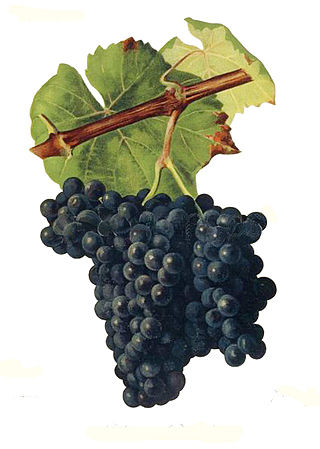
Alicante Bouschet or Alicante Henri Bouschet is a wine grape variety that has been widely cultivated since 1866. It is a cross of Petit Bouschet and Grenache. Alicante is a teinturier, a grape with red flesh. It is one of the few teinturier grapes that belong to the Vitis vinifera species. Its deep colour makes it useful for blending with light red wine. It was planted heavily during Prohibition in California for export to the East Coast. Its thick skin made it resistant to rot during the transportation process. The intense red color was also helpful for stretching the wine during prohibition, as it could be diluted without detracting from the appearance. At the turn of the 21st century, Alicante Bouschet was the 12th most planted red wine grape in France with sizable plantings in the Languedoc, Provence and Cognac regions. In 1958, Alicante Bouschet covered 24,168 hectares ; by 2011, plantings represented less than 4,000 hectares. This scenario is largely reversed in other regions of Europe, and in southern Portugal, where its wines are highly prized and frequently outscore traditional autochthonous varieties.
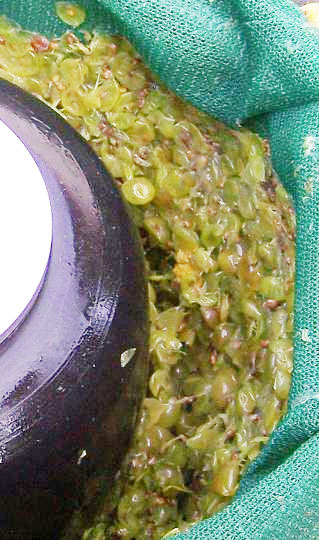
Pomace, or marc, is the solid remains of grapes, olives, or other fruit after pressing for juice or oil. It contains the skins, pulp, seeds, and stems of the fruit.

A rosé is a type of wine that incorporates some of the color from the grape skins, but not enough to qualify it as a red wine. It may be the oldest known type of wine, as it is the most straightforward to make with the skin contact method. The pink color can range from a pale "onionskin" orange to a vivid near-purple, depending on the grape varieties used and winemaking techniques. Usually, the wine is labelled rosé in French, Portuguese, and English-speaking countries, rosado in Spanish, or rosato in Italian.

Maceration is the winemaking process where the phenolic materials of the grape—tannins, coloring agents (anthocyanins) and flavor compounds—are leached from the grape skins, seeds and stems into the must. To macerate is to soften by soaking, and maceration is the process by which the red wine receives its red color, since raw grape juice is clear-grayish in color. In the production of white wines, maceration is either avoided or allowed only in very limited manner in the form of a short amount of skin contact with the juice prior to pressing. This is more common in the production of varietals with less natural flavor and body structure like Sauvignon blanc and Sémillon. For Rosé, red wine grapes are allowed some maceration between the skins and must, but not to the extent of red wine production.
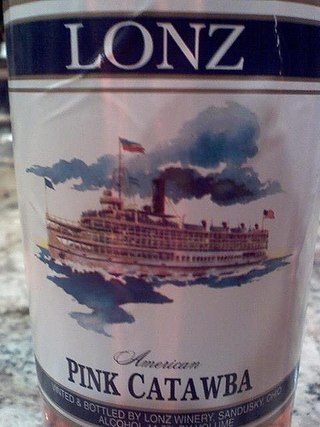
Catawba is a red American grape variety used for wine as well as juice, jams and jellies. The grape can have a pronounced musky or "foxy" flavor. Grown predominantly on the East Coast of the United States, this purplish-red grape is a likely a hybrid of the native American Vitis labrusca and the Vitis vinifera cultivar Semillon. Its exact origins are unclear but it seems to have originated somewhere on the East coast from the Carolinas to Maryland.

Saperavi is an acidic, teinturier-type grape variety native to the country of Georgia, where it is used to make many of the region's most well-known wines. It is also grown in Russia and in lesser quantities in Armenia, Moldova, Ukraine, Uzbekistan, Azerbaijan, Australia.
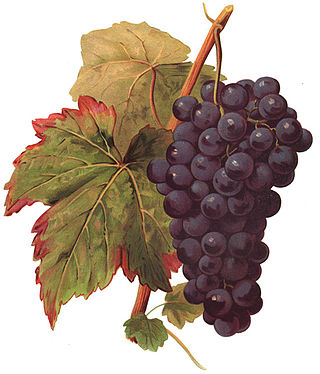
St. Laurent is a highly aromatic dark-skinned wine grape variety grown in cool climate regions of central Europe, mainly Austria and the Czech Republic. Its origin is uncertain, but the long-held belief that it is related to Pinot noir has been confirmed by DNA analysis, which shows it is an offspring of Pinot noir and a second parent, possibly Savagnin.
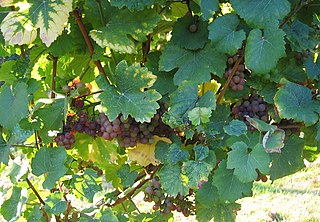
Savagnin rose or Roter Traminer is a variety of wine grape. It has a pink, reddish or brownish red skin colour, but is counted as a white wine grape since it does not have the deep purple/blue/black colour of red wine grapes.

Aramon or Aramon noir is a variety of red wine grape grown primarily in Languedoc-Roussillon in southern France. Between the late 19th century and the 1960s, it was France's most grown grape variety, but plantings of Aramon have been in continuous decline since the mid-20th century. Aramon has also been grown in Algeria, Argentina and Chile but nowhere else did it ever reach the popularity it used to have in the south of France.

Grand Noir de la Calmette is a red teinturier grape variety that is a crossing of Petit Bouschet and Aramon noir created in 1855 by French grape breeder Henri Bouschet at his vineyard in Mauguio in the Hérault department. The grape was named after the breeding station Domaine de la Calmette. As a teinturier, Grand noir is often used to add color to wines that it is blended into but is paler than other choices such as Alicante Bouschet. The vine tends to bud late and has a high productivity but with some susceptibility to the viticultural hazard of powdery mildew.
The classification of wine is based on various criteria including place of origin or appellation, vinification method and style, sweetness and vintage, and the grape variety or varieties used. Practices vary in different countries and regions of origin, and many practices have varied over time. Some classifications enjoy official protection by being part of the wine law in their country of origin, while others have been created by, for example, growers' organizations without such protection.

Algerian wine is wine cultivated and bottled in Algeria. It has played an important role in the history of wine. Algeria's viticultural history dates back to its settlement by the Phoenicians and continued under the Roman empire. Prior to the Algerian War of Independence (1954-1962), Algeria was the largest wine exporter in the world, accounting for nearly two-thirds of the total international wine trade.
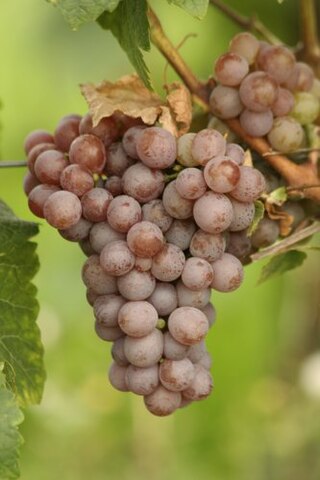
Musqué is a French term applied to certain varieties or clones of grapes used for making wine. The term means both perfumed ("musky") and Muscat-like, and indicates that the variety or clone is highly aromatic. The term musqué is usually suffixed to the name of certain grape varieties to indicate a clone with musqué properties, e.g. "Chardonnay musqué" or "Sauvignon blanc musqué". Such clones have arisen through mutation of a regular ("non-musqué") clone of the variety, and such mutations have been recorded for several different grape varieties.

The phenolic content in wine refers to the phenolic compounds—natural phenol and polyphenols—in wine, which include a large group of several hundred chemical compounds that affect the taste, color and mouthfeel of wine. These compounds include phenolic acids, stilbenoids, flavonols, dihydroflavonols, anthocyanins, flavanol monomers (catechins) and flavanol polymers (proanthocyanidins). This large group of natural phenols can be broadly separated into two categories, flavonoids and non-flavonoids. Flavonoids include the anthocyanins and tannins which contribute to the color and mouthfeel of the wine. The non-flavonoids include the stilbenoids such as resveratrol and phenolic acids such as benzoic, caffeic and cinnamic acids.
Cereza is a white Argentine wine grape variety. Like Gewürztraminer and Pinot gris, Cereza is a pink skinned variety. It is a crossing of Muscat of Alexandria and Listan negro.

The color of wine is one of the most easily recognizable characteristics of wines. Color is also an element in wine tasting since heavy wines generally have a deeper color. The accessory traditionally used to judge the wine color was the tastevin, a shallow cup allowing one to see the color of the liquid in the dim light of a cellar. The color is an element in the classification of wines.
Alicante Ganzin is a red French wine grape variety. Unlike most Vitis vinifera wine grapes, Alicante Ganzin is a teinturier with dark flesh that produces red juice. Most varieties used to produce red wine, such as Cabernet Sauvignon, Syrah, etc., have clear color flesh and juice with the wine receiving its color through a maceration process where the color seeps out of the grape skins for as long as they are in contact with the juice. Alicante Ganzin can thus produce light red and rose colored wine without maceration. It is believed that Alicante Ganzin is often described as the progenitor of all French teinturier grapes.

Olmo grapes are wine and table grape varieties produced by University of California, Davis viticulturist Dr. Harold Olmo. Over the course of his nearly 50-year career, Dr. Olmo bred a wide variety of both grapes by means of both crossing varieties from the same species or creating hybrid grapes from cultivars of different Vitis species.
Petit Bouschet is a red teinturier grape variety that is a crossing of Aramon noir and Teinturier du Cher created in 1824 by French grape breeder Louis Bouschet at his vineyard in Mauguio in the Hérault department. The grape was used by Louis' son, Henri Bouschet, to create several more varieties including Alicante Bouschet, Grand Noir de la Calmette and Morrastel Bouschet. Petit Bouschet saw a surge of plantings in the late 19th century as France recovered from the phylloxera epidemic where it was often used to add color to blends made from hybrid grapes and other high yielding varieties. As its offspring Alicante Bouschet became more popular, plantings of Petit Bouschet fell off and the grape is now hardly found in France.
Royalty is a rouge Californian wine grape variety that was developed in 1938 by Dr. Harold P. Olmo of the University of California, Davis. The grape is a red fleshed teinturier which, unlike most red wine grapes, will produce red-tinged colored wine even without maceration time on the skins. The grape is a hybrid being produced from the Vitis vinifera Trousseau gris variety from the Jura wine region of France and the teinturier grape Alicante Ganzin that, itself, is a hybrid of a Vitis rupestris variety and the Vitis vinifera grape Aramon.
2. Modern Grapes for the Pacific Northwest, by Kenton Erwin















